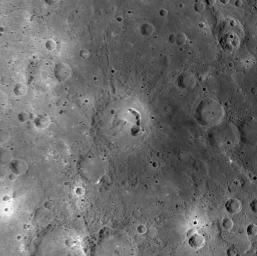
|
Pits, Picasso, and Mercury’s History
- Click the image above for a larger view
- Full-Res JPEG (1213 x 1207) (186.7 kB)
- Full-Res TIFF (1213 x 1207) (1.5 MB)
Caption:
The crater pictured in the center of this image was recently named Picasso , in honor of the Spanish painter and sculptor Pablo Picasso (1881-1973). This crater, first imaged during MESSENGER's third Mercury flyby , has drawn scientific attention because of the large, arc-shaped pit located on the eastern side of its floor. Similar pits have been discovered on the floors of several other Mercury craters, such as Beckett and Gibran . These pits are postulated to have formed when subsurface magma subsided or drained, causing the surface to collapse into the resulting void. If this interpretation is correct, pit-floor craters such as Picasso provide evidence of shallow magmatic activity in Mercury's history.
Date Acquired:
September 29, 2009
Instrument:
Narrow Angle Camera (NAC) of the Mercury Dual Imaging System (MDIS)
Resolution:
500 meters/pixel (0.31 miles/pixel)
Scale:
The diameter of Picasso is 133 kilometers (83 miles)
Projection:
This image is a portion of
the NAC approach mosaic from Mercury flyby 3
. It is shown in a
simple cylindrical map projection
.
Background Info:
These images are from MESSENGER, a NASA Discovery mission to conduct the first orbital study of the innermost planet, Mercury. For information regarding the use of images, see the MESSENGER image use policy .
Cataloging Keywords:
| Name | Value | Additional Values |
|---|---|---|
| Target | Mercury | |
| System | ||
| Target Type | Planet | |
| Mission | MESSENGER | |
| Instrument Host | MESSENGER | |
| Host Type | Orbiter | |
| Instrument | Mercury Dual Imaging System (MDIS) | |
| Detector | Narrow Angle Camera (NAC) | |
| Extra Keywords | Crater, Grayscale, Map | |
| Acquisition Date | ||
| Release Date | 2010-05-25 | |
| Date in Caption | 2009-09-29 | |
| Image Credit | NASA/Johns Hopkins University Applied Physics Laboratory/Carnegie Institution of Washington | |
| Source | photojournal.jpl.nasa.gov/catalog/PIA13468 | |
| Identifier | PIA13468 | |
